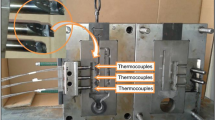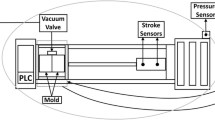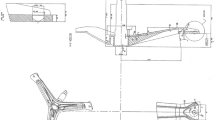Abstract
Be–Al alloy castings are widely used in aviation, aerospace and marine industries due to their excellent comprehensive properties. To improve the quality of products, vacuum investment casting of a bracket casting of Be–Al alloys was simulated using the finite-element method and the evolution of the flow field and temperature field as well as the formation of shrinkage porosity were simulated. The simulated results of positions of shrinkage porosity agreed well with the experimental results. The optimized casting parameter with ceramic shell preheat temperature of 500 °C and pouring temperature of 1300 °C was determined by numerical simulation. After the process optimization, a high quality Be–Al alloy casting was successfully produced by pouring once.












Similar content being viewed by others
References
X.N. Liu, S.G. Ma, Study and application of AlBe alloy. Chin. J. Rare Metals 27(1), 62–65 (2003)
W. Speer, S.E. Omar, Application of aluminum-beryllium composite for structural aerospace component. Eng. Fail. Anal. 11(6), 895–902 (2004)
J.W. Elmer, M.J. Aziz, L.E. Tanner et al., Formation of bands of ultrafine beryllium particles during rapid solidification of Al–Be alloy: modeling and direct observation. Acta Metall. Mater. 42(4), 1065–1080 (1994)
D. Carter, M. Bourke, Neutron diffraction study of the deformation behavior of beryllium-aluminum composites. Acta Mater. 48(11), 2885–2900 (2000)
M. Rappaz, C.A. Gandin, Probabilistic modeling of microstructure formation in solidification processes. Acta Metall. Mater. 41(2), 345–360 (1993)
L. Nastac, Numerical modeling of solidification morphologies and segregation patterns in cast dendritic alloys. Acta Mater. 47(17), 4253–4262 (1999)
F. Shehata, M. Abd-Elhamid, Computer aided foundry die-design. Mater. Des. 24(8), 577–583 (2003)
L. Beltran-Sanchez, D.M. Stefanescu, A quantitative dendrite growth model and analysis of stability concepts. Metall. Mater. Trans. A 35(8), 2471–2485 (2004)
B.C. Liu, S.M. **ong, Q.Y. Xu, Study on macro- and micro modeling of the solidification process of aluminum shape casting. Metall. Mater. Trans. B 38(4), 525–532 (2007)
G.F. Mi, X.Y. Liu, K.F. Wang, H.Z. Fu, Numerical simulation of low pressure die-casting aluminum wheel. China Foundry 6(1), 48–52 (2009)
I. Khaled, Prediction of shrinkage porosity in Ti-46Al-8Nb tilt-casting using the Niyama criterion function. Int. J. Metalcast. 7(4), 35–42 (2013)
Y. Fang, J. Hu, J.X. Zhou et al., Numerical simulation of filling and solidification in exhaust manifold investment casting. Int. J. Metalcast. 8(4), 39–45 (2014)
J.L. Li, R.S. Chen, Y.Q. Ma, W. Ke, Characterization and prediction of microporosity defect in sand cast WE54 alloy castings. J. Mater. Sci. Technol. 30(10), 991–997 (2014)
L. Yang, L.H. Chai, Y.F. Liang, Numerical simulation and experimental verification of gravity and centrifugal investment casting low pressure turbine blades for high Nb–TiAl alloy. Intermetallics 66, 149–155 (2015)
S.Y. Zhang, J.S. Li, H.C. Kou et al., Numerical modeling and experiment of counter-gravity casting for titanium alloys. Int. J. Adv. Manuf. Technol. 85(5–8), 1877–1884 (2016)
M.Y. Hu, J.J. Cai, W.L. Sun et al., Diecasting simulation and process optimization of an A356 aluminum alloy polishing plate. Int. J. Metalcast. 10(3), 315–321 (2016)
ProCAST User’s Manual & Technical Reference. America: ESI Software Inc., 2007
Q. Tian, W.G. Wang, J.X. Zhou et al., Application of reverse thermophysical parameters technology in lost foam casting ductile casting. Spec. Cast. Nonferr. Alloys 35(3), 288–291 (2015)
Acknowledgements
This work was financially supported by the Science and Technology Development Foundation of Chinese Academy of Engineering Physics under Grant No. 2015B0203031, and the Science Challenge Program of China under Grant No. TZ20160040201. The authors would like to thank Prof. Haidong Zhao for 3D characterizations of the shrinkage porosities in the present article.
Author information
Authors and Affiliations
Corresponding author
Rights and permissions
About this article
Cite this article
Wang, Z.H., Wang, J., Yu, L.B. et al. Numerical Simulation and Process Optimization of Vacuum Investment Casting for Be–Al Alloys. Inter Metalcast 13, 74–81 (2019). https://doi.org/10.1007/s40962-018-0228-1
Published:
Issue Date:
DOI: https://doi.org/10.1007/s40962-018-0228-1




